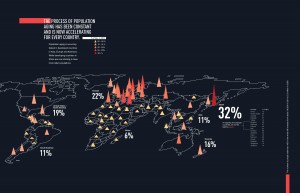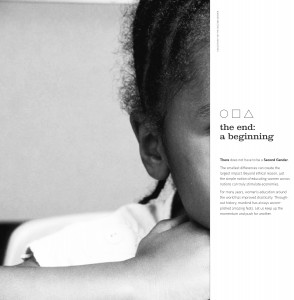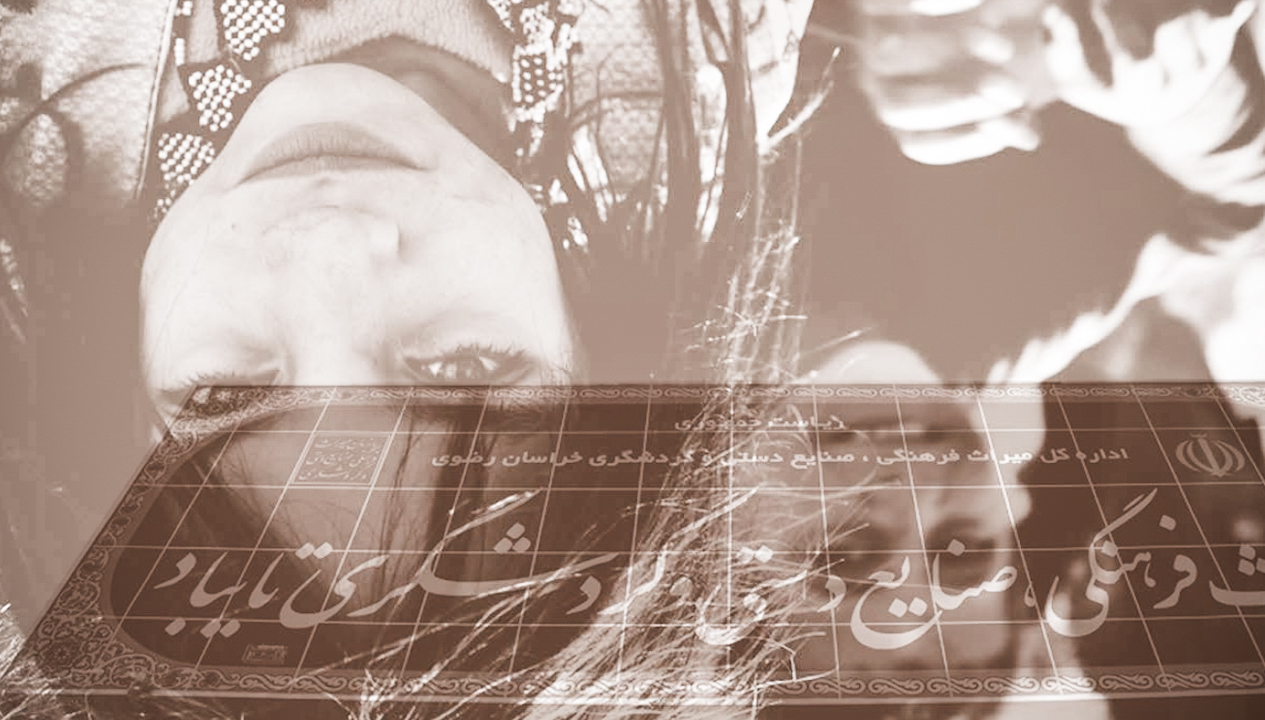Ramone Muñoz, who has been teaching at Art Center for nearly 30 years, enjoys giving students design challenges with heavy research components. The class project from last Fall entitled “Perspectives” has been assigned a few times over the last 20 years.

 The subjects chosen are often poorly understood by many Americans, as well as people in other countries. The booklets developed by the students are adaptable to any language and could be published by the United Nations. Although such information could be effectively addressed as an online design problem, the intent of the project, and the foundation level class generally, is to expose students to sequential design, narrative thinking and compositional problems within the context of analog editorial and book graphics. Students are also learning how to use typography and images to communicate effectively.
The subjects chosen are often poorly understood by many Americans, as well as people in other countries. The booklets developed by the students are adaptable to any language and could be published by the United Nations. Although such information could be effectively addressed as an online design problem, the intent of the project, and the foundation level class generally, is to expose students to sequential design, narrative thinking and compositional problems within the context of analog editorial and book graphics. Students are also learning how to use typography and images to communicate effectively.
Driven by my own curiosity regarding what the United Nations actually does and how it can educate the public about its efforts to improve conditions for humanity throughout the world, I developed an assignment that challenges students to select an issue dealing with the human condition such as war, hunger, pollution, natural disasters, economic challenges, the mistreatment of women, minorities, children, etc. The students must find out as much as possible, through many weeks of research, about their chosen subject and discover how the U.N. approaches the problem.
 Specifically, the purpose of these informational booklets is to create better connections within the world community and an understanding of the role the United Nations plays in monitoring areas of unrest, inequality and other challenges to humanity. The students are given some specific goals which include: 1. To introduce the overall subject such as: the conflict between Israel and Palestine. 2. Present a brief and concise history or timeline of the countries or geographic locations associated with the issue. 3. Explain the political, economic, philosophical or religious differences that may be the cause of the conflict or situation being addressed. 4. Address some of the theoretical approaches as possible ways to end the conflict or reduce the impact of the issue on humanity. 5. The booklet should have a form of closure including recommended readings and articles. On a design level students are also challenged to create an organizational hierarchy within this booklet and a successful synthesis between images and the written word.
Specifically, the purpose of these informational booklets is to create better connections within the world community and an understanding of the role the United Nations plays in monitoring areas of unrest, inequality and other challenges to humanity. The students are given some specific goals which include: 1. To introduce the overall subject such as: the conflict between Israel and Palestine. 2. Present a brief and concise history or timeline of the countries or geographic locations associated with the issue. 3. Explain the political, economic, philosophical or religious differences that may be the cause of the conflict or situation being addressed. 4. Address some of the theoretical approaches as possible ways to end the conflict or reduce the impact of the issue on humanity. 5. The booklet should have a form of closure including recommended readings and articles. On a design level students are also challenged to create an organizational hierarchy within this booklet and a successful synthesis between images and the written word.
“One of the very interesting outcomes of this assignment is that students discover that issues are always more complex than we think they are. Also, as a diplomatic organization, the United Nations must maintain a certain level of neutrality while also trying to create change that betters humanity. It is a tall order that often requires great patience. In some cases, one may find that certain situations seem hopeless, and yet, there is always hope when there are efforts towards better understanding. If that were not the case, we would still be in the Dark Ages.”
– Ramone Munoz, Faculty, Graphic Design
 Some of the topics addressed by students for this assignment included: World population aging, The conflict between Israel and Iran, Farming and sustainability in Sudan, the challenges of cap and trade, the education of women in India, PTSD in the indigenous populations of Kabul- Afghanistan, and the vanishing bee populations throughout the world.
Some of the topics addressed by students for this assignment included: World population aging, The conflict between Israel and Iran, Farming and sustainability in Sudan, the challenges of cap and trade, the education of women in India, PTSD in the indigenous populations of Kabul- Afghanistan, and the vanishing bee populations throughout the world.
